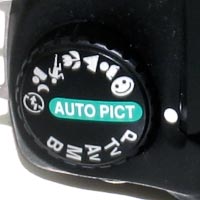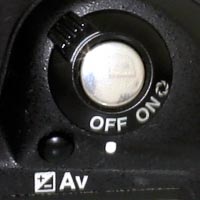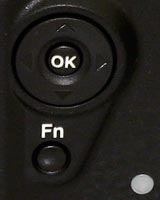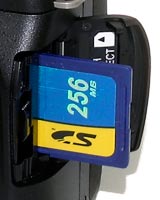Pentax *ist DS
Review Date: June 23rd 2005
|
Ease of Use
Weighing only 505g and measuring 125(W) x 92.5(H) x 66(D)mm, the Pentax *ist DS is the smallest digital SLR camera that I have ever used. Its diminutive size is due in part to the use of SD memory cards rather than Compact Flash. Pentax have prevented the *ist DS from being too cluttered by keeping the number of external controls to a minimum - just 14 in total - which is unusual for a DSLR camera. This apparent simplicity does, however, make the Pentax *ist DS well suited for its target market of beginner SLR users and people upgrading from compact digicams.
So the Pentax *ist DS is a relatively small and compact camera, but what is it actually like to handle and use? Despite being so small, the *ist DS is still extremely comfortable in terms of handling. The camera has a very deep, contoured handgrip on the right-hand side, coated in a rubberized compound to aid grip, that enabled me to use three fingers to hold it and my right forefinger to operate the shutter button. I could comfortably hold the camera with one hand if so desired. There is also a contoured area where your right thumb sits, with the rest of the body finished in a mixture of matt black, slightly textured plastic. The rather light and plasticky 18-55mm lens feels well-balanced on the Pentax *ist DS and it fits into place with a reassuring mechanical click. This mechanical theme continues with the shutter release action on the Pentax *ist DS, which is the loudest that I have heard on any camera - you will either love or hate this feature. I liked it, although it isn't great for close-up candid photography as your subject will undoubtedly hear you. Overall the Pentax *ist DS feels solid and business-like, which is quite an achievement considering the aggressive price-point.
| Exposure Mode Dial | On/Off Switch / Shutter Button / Exposure Compensation Button |
 |
 |
The Pentax *ist DS is generally very well-made, with most of the external controls again feeling more expensive than they actually are. I really liked the SD Memory Card slot, which is protected by a cover that is opened by a sliding catch, preventing accidental removal of the card and possible data corruption if an image is being written to it. The metal shutter release button has a positive action, and is surrounded by a circular switch which not only turns the camera on and off, but also accesses the Depth of Field Preview feature. This is a much more logical position than on my own Canon EOS 10D camera (a small button on the front of the camera). Thoughtful positioning of key controls continues with the Exposure Compensation button (labeled Av), which is located next to the shutter button. Hold down the Av button with your right forefinger and spin the dial on the top-rear of the camera with your thumb to adjust the exposure - simple and intuitive. This dial also allows you to select apertures/shutter speeds and zoom in and out when viewing an image on the LCD screen. You really do get a lot for your money in terms of build-quality and overall design - this camera may be made of plastic, but it's still amazing that you can get this level of workmanship at this kind of price.
Considering that this is a complicated digital SLR camera with an array of advanced features, the Pentax *ist DS has a very clean and uncluttered design that will be familiar to anyone who has used a DSLR before, and not too intimidating for someone who hasn't used one. I counted 14 external controls in total, which actually makes it less complex than many compact digicams! This helps to make it accessible to its target market of first-time digital SLR users, although I strongly recommend that you read through the excellent user guide first, which contrary to recent trends is actually printed rather than supplied on a CD. The Pentax *ist DS follows conventional DSLR design in having a shooting mode dial on the top-left of the camera, which allows you to select either an advanced mode like Aperture-priority or one of 7 commonly-used scene modes.
| Menu Button / Delete Button / Info Button / Play Button | Arrow Pad / OK Button / Function Button / Activity LED |
 |
 |
The LCD panel on top of the camera displays quite a comprehensive amount of information, including the shooting mode, current aperture or shutter speed, flash mode, battery level, drive mode, focus point, metering, white balance and the number of remaining frames. An even greater number of settings (14 in total) are displayed in the viewfinder. Also when you change the shooting mode, a summary of the settings is briefly displayed on the main LCD screen, and you can press the Info button at any time to display even more details. The Pentax *ist DS does a very good job of providing easily understood information about the settings that it is using.
So far so good - now we come to an aspect of the camera that I am less enthusiastic about, namely the menu system. Pentax have split the various menu settings into two, accessed by separate buttons on the rear of the camera. The Fn button allows you to set white balance, drive mode, ISO speed and the flash mode. This grouping of a few features has allowed the Pentax designers to keep the small body as uncluttered as possible, but at the same time key controls like the ISO speed are a two-step process to access (a button press and a menu selection), rather than one as on many DSLRs. The Menu button then accesses all of the other menu options that the camera offers. With this being a DSLR there are a lot of them - I counted 48 in total split into 4 sub-menus. Thankfully you will only have to set about half of the settings once and can then forget about them. I would personally prefer to see all the menu options consolidated in one place, so that I don't have to remember which specific option is in which of the two menus. Otherwise the menu system has a logical tabbed system and is easily readable, with a bright display and a large font size making it perfectly readable even in low light.
| Battery Compartment | Memory Card Compartment |
 |
 |
The start-up time of the Pentax *ist DS, from turning the camera on to being ready to take a photo, is very quick for a DSLR at just over 1 second. Focusing is also quick and consistent in good light with the standard kit lens and the camera happily achieves focus indoors and in low-light situations. The AF Assist light can only be used if the built-in flash is raised though. The 15-55mm kit lens does have a rather noisy focusing mechanism, but if you are upgrading from a compact digicam you probably won't care too much as the Pentax *ist DS focuses more quickly and with a higher hit rate. The large 2 inch LCD screen is bright, clear and has a perfectly acceptable refresh rate. It takes about 2 seconds to store a JPEG image at the highest quality setting with no discernible lockup between taking shots, allowing you to keep shooting as they are being recorded onto the memory card. For RAW images the Pentax *ist DS takes about 6 seconds to store an image and there is also no lockup between shots until the buffer of 5 images is reached - at this point you can still see through the viewfinder but you can't fire the shutter until the buffer has cleared. In the continuous shooting mode you can hold down the shutter button and take one RAW photo roughly every 0.5 seconds for up to 5 images. In the best quality JPEG mode you can take 8 images at the same rate of one every 0.5 seconds.
Once you have captured a photo, the Pentax *ist DS has an above average range of options for playing, reviewing and managing your images. You can scroll through the images that you have taken, view thumbnails, zoom in and out up to a magnification of 12x, and see fairly detailed information about each image by pressing the Info button. You can also delete an image, rotate an image, view a slideshow, lock images so that they cannot be deleted, and set various printing options. There are also a few digital effects available which can be applied to JPEGs - Black and White, Sepia, Soft and Slim, which effectively resizes an image. The camera shows you a preview of what the effect will look like when applied, and the effect is applied to a copy of your image, thus preserving the original intact. Importantly the Pentax *ist DS offers a histogram after taking a photo which is a great help in evaluating the exposure, plus any areas that are over-exposed flash on and off in the LCD preview to show you want you should be compensating for with your next attempt.
In summary the Pentax *ist DS is a very compact, easy to use DSLR that is well-made, with no corners being cut despite the low price-point. There are lots of nice touches which show that the Pentax designers have put a lot of thought into how the camera will be used, and the camera is very responsive.
|
 PhotographyBLOG is a member of the DIWA organisation. Our test results for the Pentax *ist DS have been submitted to DIWA for comparison with test results for different samples of the same camera model supplied by other DIWA member sites.
PhotographyBLOG is a member of the DIWA organisation. Our test results for the Pentax *ist DS have been submitted to DIWA for comparison with test results for different samples of the same camera model supplied by other DIWA member sites.
